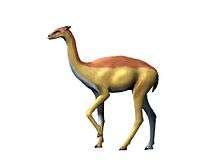Aepycamelus
| Aepycamelus Temporal range: early Miocene–late Miocene | |
|---|---|
 | |
| Restoration by Heinrich Harder | |
| Scientific classification | |
| Kingdom: | Animalia |
| Phylum: | Chordata |
| Class: | Mammalia |
| Order: | Artiodactyla |
| Family: | Camelidae |
| Tribe: | Camelini |
| Genus: | Aepycamelus MacDonald, 1956 |
| Species | |
|
†Aepycamelus alexandrae | |
Aepycamelus is an extinct genus of camelid, formerly called Alticamelus, which lived during the Miocene 20.6–4.9 million years ago, existing for about 15.7 million years.[1] Its name is derived from the Homeric Greek αἰπύς, "high and steep" and κάμηλος – "camel"; thus, "high camel"; alticamelus in Latin.
Aepycamelus walked on its toes only. Unlike earlier species of camelids, they possessed cushioned pads like those of modern camels.[2]
Morphology

Aepycamelus was a prairie dweller of North America (Colorado, etc.). It was a highly specialized animal. Its head was relatively small compared with the rest of its body, its neck was long, as a result of giraffe-like lengthening of the cervical vertebrae, and its legs were long and stilt-like, with the elbow and knee joints on the same level. The top of its head would have been about 3 m (9.8 ft) above the ground.[2]
Its strange body structure gives information on its mode of life and habits. Aepycamelus obviously inhabited dry grasslands with groups of trees. It is presumed to have moved about singly or in small groups, like today's giraffes, and like them, browsed high up in the trees. In this respect, it had no competitors. It survived a relatively long time, through most of the Miocene epoch, and died out prior to the start of the Pliocene, possibly due to climatic changes.[3]

Fossil distribution
Its fossils are distributed widely, from Montana to Florida to California.
References
- ↑ PaleoBiology Database: Aepycamelus, basic info
- 1 2 Palmer, D., ed. (1999). The Marshall Illustrated Encyclopedia of Dinosaurs and Prehistoric Animals. London: Marshall Editions. p. 277. ISBN 978-1-84028-152-1.
- ↑ Flannery, T. (2001). The Eternal Frontier: an ecological history of North America and its peoples. New York: Grove Press. p. 111. ISBN 0-8021-3888-8.
- Benes, Josef. Prehistoric Animals and Plants. Pg. 248. Prague: Artua, 1979.